Fact check: the 112 litre ‘Jopen’ barrels
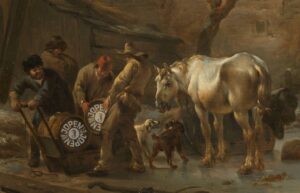 Congratulations to Jopen in 2014: it was exactly thirty years ago that this brewery released its first beer, and the taps are still running, in their home town Haarlem. An occasion to celebrate! However, where does that name ‘Jopen’ come from? From the Medieval 112 litre barrels in which Haarlem beer was shipped, as the story goes. So let’s fact check that.
Congratulations to Jopen in 2014: it was exactly thirty years ago that this brewery released its first beer, and the taps are still running, in their home town Haarlem. An occasion to celebrate! However, where does that name ‘Jopen’ come from? From the Medieval 112 litre barrels in which Haarlem beer was shipped, as the story goes. So let’s fact check that.
In 1995 the city of Haarlem in the Netherlands was to celebrate its 750th birthday. Anticipating this festive occasion, a few local beer lovers founded the Haarlem Beer Society. Its goal: to treat the people of Haarlem to a genuine historical beer. After all, in the Middle Ages Haarlem was of the most important brewing cities of the Low Countries. The old city byelaws seemed to provide enough information to revive Haarlem’s lost beers. A new recipe was created by the University of Leuven based of historical information. Also, a new brand was conceived, Jopen, and so on 11 November 1994, in the brewers’ chapel of the Saint Bavo church, the Jopen Hoppenbier was presented to the world.
It marked the start of one of the most important ‘craft’ breweries in the country. Soon, more beer types joined the brewery’s line-up, such as extra stout, bock white beer and Mooie Nel IPA. For years, the beer was produced elsewhere, but in 2010 Jopen moved into an old church building in the city centre, from then on known as the ‘Jopen Church’. They also started brewing there. A larger brewery was opened in 2014 in the Waarderpolder industrial area. Today, Jopen offers an overwhelming range of beers, with IPA, saison, gose, triple, seasonal beers and creative rarities with funny sounding names such as ‘Helles in Wonderland’, ‘Is that spelt ryeght?’ and ‘Viva el rye’. Sounds funny, tastes fine.
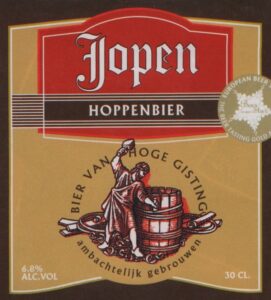
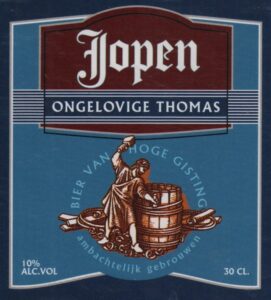 Yet, they haven’t forgotten their original focus on beer history, if only because of their name ‘Jopen’. After all, as you can read on their website and in countless other places, during the 14th century the breweries of Haarlem were operating full swing, ‘and the beer is transported via the Spaarne river in Jopen, 112 litre beer barrels.’ This little story once graced their labels and still pops up frequently in all sorts of documentation about the brewery.
Yet, they haven’t forgotten their original focus on beer history, if only because of their name ‘Jopen’. After all, as you can read on their website and in countless other places, during the 14th century the breweries of Haarlem were operating full swing, ‘and the beer is transported via the Spaarne river in Jopen, 112 litre beer barrels.’ This little story once graced their labels and still pops up frequently in all sorts of documentation about the brewery.
So you think, cool, I’d love to see such a 112 litre ‘jopen’ barrel then. But there is a catch. Once you start searching through Dutch beer history, you’ll find all sorts of barrels of various sizes. The 155 litre ‘grofton’, the 124 litre ‘smalton’, the ‘smalvat’ or the 121 litre Rostock herring barrel, not to mention a myriad of barrels of a defined form and size: casks, vats, kegs, tuns, Hamburg barrels, but… no ‘jopen’ (or what is apparently its singular form, ‘joop’), and certainly none containing 112 litres.[1]
Okay, what does that mean? A while ago I asked Leendert Alberts, an expert on Medieval Dutch beer history. He too had never heard of a barrel called ‘jopen’. But he did know a beer called ‘jopen’: the jopen beer from the city of Danzig, now known as Gdansk in Poland.
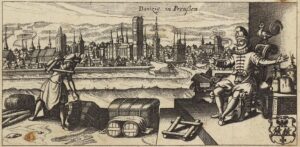 This city, member of the Hanseatic league, was renowned for its top-heavy, pitch black beer that was exported to the Low Countries from the 16th century onwards. This heavy and syrupy beer was often taken on ships as part of the provisions, because it occupied relatively little space. Up until the First World War it was still produced in Danzig, oddly based on spontaneous fermentation. In the end it was so heavy that it was used more as a medicine than as a beverage for enjoyment.[2]
This city, member of the Hanseatic league, was renowned for its top-heavy, pitch black beer that was exported to the Low Countries from the 16th century onwards. This heavy and syrupy beer was often taken on ships as part of the provisions, because it occupied relatively little space. Up until the First World War it was still produced in Danzig, oddly based on spontaneous fermentation. In the end it was so heavy that it was used more as a medicine than as a beverage for enjoyment.[2]
In any case, Dutch breweries were quick to copy this popular beer type. And so, on Christmas Eve 1544 the Haarlem city council issued an ordonnance on the prices of local beers, including single and double kuit and the ‘hoppen or Haarlem joopen beer’. The hoppenbier of Haarlem, which already had been around for over a century and which was dark-coloured (contrary to the current Hoppenbier brewed by today’s Jopen brewery), was apparently thought to be similar to the jopenbier of Danzig. It was the first and only time that any Haarlem beer was referred to as ‘jopenbier’ (at least, until 1994 of course).[3]
And it could have stayed at that, if the Haarlem Beer Society hadn’t been founded, in 1994. Its goal was to revive and promote the traditional beers of Haarlem. They studied historical archives and literature and found recipes for koyt (from 1407) and hoppenbier (from 1501). The first beer chosen to be brought back to life was the hoppenbier, for which a new recipe was compiled by Belgian beer professor Freddy Delvaux and master brewer Etienne Moerman, based on the old documents.[4]
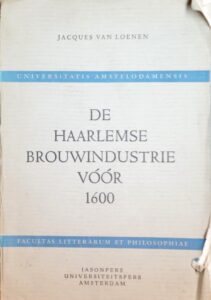 Still, the Society needed a name for its new brand. So, they looked at a 1950 dissertation on the history of the Haarlem brewing industry, written by one Jacques Cornelis van Loenen. There, they found the mention quoted above, of the ‘Haarlem joopen beer’ from 1544. Here, the devil is in the detail, in this case a footnote added by Van Loenen: ‘Joopen beer, as named after the joopen or barrels in which it was shipped.’
Still, the Society needed a name for its new brand. So, they looked at a 1950 dissertation on the history of the Haarlem brewing industry, written by one Jacques Cornelis van Loenen. There, they found the mention quoted above, of the ‘Haarlem joopen beer’ from 1544. Here, the devil is in the detail, in this case a footnote added by Van Loenen: ‘Joopen beer, as named after the joopen or barrels in which it was shipped.’
The Haarlem Beer Society was happy not to ask any more questions back in 1994, and thought: mmm, barrels called ‘joopen’, that sounds like a cool name for our brand. But actually, Van Loenen made a mistake here. There actually was no such thing as a barrel called ‘joopen’, but there did exist barrels called ‘jopenvat’. Which were, of course, simply barrels of various sizes with jopenbier from Danzig in it. That’s not the same as a barrel called ‘jopen’ of a determined size containing any type of Haarlem beer!
Van Loenen suggests the beer was named after the barrels, but it was just the other way around.[5] He should have known this, because elsewhere in his dissertation (on page 80), he does mention the jopenbier of Danzig, in a section on imported beers.
Anyway, the Haarlem Beer Society had their brand name. But the next question is, why on earth do they claim these so-called ‘jopen’ barrels had a size of exactly 112 litres? Because, as said, no barrels of that size ever existed. I did try to find the answer by asking my contacts in Haarlem, but no-one could tell me where they had found these 112 litre barrels. So went and looked at the sources they used, such as the book by Jacques van Loenen.
I suspect that back in 1994, the Haarlem Beer Society was just very eager to find out how big these supposed barrels called ‘jopen’ were. However, Van Loenen’s book never supplies this information (how could it, these barrels never existed). So, they had to be inventive. Actually, I suspect they looked at Van Loenen’s calculation of total beer consumption in Haarlem.
Of the city’s beer consumption in the 16th century, it was known how many barrels of beer the people of Haarlem drank in total, and Van Loenen wanted to convert this to the number of litres. Doing so, he claimed: ‘A barrel of beer held 88 to 91 mengel [a certain old unit of measurement]. One mengel was equal to 1 ¼ litres.’[6] The good people of the Haarlem Beer Society must have reasoned like this, back in 1994: okay, so on page 35 a ‘jopen’ is apparently a beer barrel, on page 58 a (nameless) barrel is the average of 88 and 91, times 1.25 = 111.875 litres. Or rounded off that makes 112 litres…
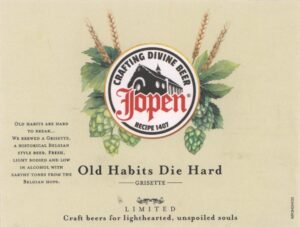 Holy cow, that’s one sloppy bit of beer history writing. On top of that, in Haarlem the size of a mengel was not 1.25 litres but only 0.81 litres, so the calculation was wrong anyway.[7] In short, those 112 litre barrels were invented out of thin air.
Holy cow, that’s one sloppy bit of beer history writing. On top of that, in Haarlem the size of a mengel was not 1.25 litres but only 0.81 litres, so the calculation was wrong anyway.[7] In short, those 112 litre barrels were invented out of thin air.
In conclusion: it’s fantastic that Jopen has been brewing excellent Haarlem beer for thirty years now. But contrary to what they’ve claimed all this time, there never were any beer barrels called ‘jopen’ or ‘joop’, and they certainly didn’t have the size of 112 litres. Instead, the brand name ‘Jopen’ hails back, as we saw, to Christmas Eve 1544, when the city council for just once equated the hoppenbier of Haarlem to the jopenbier of Danzig. Incidentally, I already pointed this out to the people of the Jopen brewery a few years ago, but I still find the 112 litre story on their website. Or as the name of one of their beers has it, ‘Old habits die hard’…[8]
[1] Cf. Leen Alberts, ‘Bier drinken met maten. Dronkenschap en het alcoholgehalte van Stichtse en Hollandse bieren in de late middeleeuwen’, in: Jaarboek voor de Middeleeuwse geschiedenis vol. 13 (2010), p. 113-166.
[2] Roel Mulder, Verloren bieren van Nederland, Houten 2017, p. 129-130.
[3] Jacques Cornelis van Loenen, De Haarlemse brouwindustrie vóór 1600, Amsterdam 1950, p. 35.
[4] PINT Magazine 183 (April 2011), p. 16.
[5] Van Loenen probably looked it up in a dictionary, such as the Woordenboek der Nederlandsche Taal (Dictionary of the Dutch Language), that doesn’t mention ‘jopen’, but it does mention a ‘jopenvat’.
[6] Van Loenen, De Haarlemse brouwindustrie, p. 58.
[7] Cf. Alberts, ‘Bier drinken met maten’, p. 155. Incidentally, in Amsterdam a mengel was as large as 1.25 litres, cf https://www.meertens.knaw.nl/mgw/maat/37.
[8] Unfortunately, the 1994 and 1995 reconstructions of hoppenbier and koyt are quite misguided. Hoppenbier wasn’t blond but dark, and koyt was blond or even white, and it didn’t contain gruit instead of hops. In any case, the reconstructions are still very tasty beers.
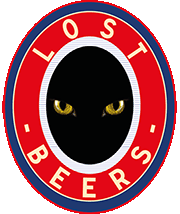





Leave a Reply